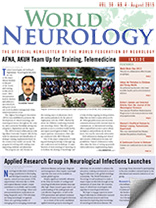By Dan G. Blazer, MD, MPH, PhD, Kristine Yaffe, MD, and Jason Karlawish, MD
Review and Commentary by Rita A. Shapiro, DO, FAAN, FACP
There is intense individual and public concern over cognitive decline in aging. What may seem like minor forgetfulness when young can result in intense fear of progressive cognitive decline and loss of independence for older individuals. In the U.S. and throughout most of the world, human life expectancy and the number of older adults continues to grow. Ongoing analysis and planning, including inventions that promote healthy aging and cognition, are crucial. Cognitive decline impacts individuals and families as well as society. Treatment and supportive measures consume a high portion of health care dollars and resources by health care providers, social and other services, and public health.
The Institute of Medicine convened a committee in 2014 chaired by Dr. Dan Blazer, a renowned geriatric psychiatrist, of 16 experts from a wide range of disciplines to study and make recommendations regarding the public health aspects of cognitive aging (CA). Dr. Blazer authored the report. By design, the committee did not focus on Alzheimer’s disease or other dementias or on basic science. The authors distinguished CA from cognitive impairment.
The CA report was written for a broad audience, including the general public; health care and human services providers; local, state and national policy makers; researchers; foundations and nonprofit organizations. The 2015 full report and a briefer version can be viewed at: http://iom.nationalacademies.org/Reports/2015/Cognitive-Aging. The multifaceted recommendations included definitions and terminology for CA, epidemiology and surveillance, prevention and intervention opportunities, education of health professionals and the public, as well as increasing public awareness.
Terminology for cognition is variable and not yet standardized. The authors defined cognitions as “the mental functions involved in attention, thinking, understanding, learning, remembering, solving problems and making decisions that are needed for individuals to successfully negotiate the world.” They point out that cognition is multidimensional and involves more than memory alone. CA is a lifelong process of “gradual, ongoing, yet highly variable changes in cognitive functions that occur as people get older.” Cognitive health was “exemplified by an individual who maintains his or her optimal cognitive function with age.”
Key features of CA are:
- Inherence in humans and animals
- Occurs across the spectrum of individuals
- Highly dynamic variable process within and between individuals
- Biology is just beginning to be understood but involves structural and functional brain changes.
CA is “not a clinically defined neurological or psychiatric disease such as Alzheimer’s disease and does not inevitably lead to neuronal death and neurodegenerative dementia (such as Alzheimer’s disease). Risk and protective factors include health and environmental factors throughout the lifespan influencing cognitive aging; modifiable and nonmodifiable factors (genetics, culture, education, medical comorbidities, acute illness, physical activity and other health behaviors) and the influence of development (beginning in utero, infancy and childhood) on cognitive aging. The recognition of developmental influences on cognition later in life is a newer concept.
The authors discuss the shortcomings of normative data and recommend the development of better tools to assess CA and cognitive trajectories. “Cognitive aging is not easily defined by a clear threshold on cognitive tests since many factors, including culture, occupation, education, environmental context and health variables (e.g., medications, delirium) influence test performance and norms.” The authors explained that for an individual, comparing cognitive performance is best assessed at several points in time.
Cognitive aging also was characterized by an impact on daily life:
- Day-to-day functions, such as driving, making financial and health care decisions, and understanding instructions given by a health care professional, may be affected.
- Experience, expertise and environmental support aides (e.g., lists) can help compensate for declines in cognition.
- The challenges of cognitive aging may be more apparent in environments that require individuals to engage in highly technical and fast-paced or times tasks, in situations that involve new learning, and in stressful situations … and may be less apparent in highly familiar situations.
The potential impact of CA on driving, decision-making and understanding health care instructions is discussed.
The report aids in rectifying some common incorrect assumptions about older adults such as “it’s all downhill” or that cognitive decline is inevitable, although only a small minority of older adults develop dementia. The authors note the wide heterogeneity among older adults and variability with CA. Some cognitive functions show decline (e.g., speed of information processing, some aspects of attention and memory), others are relatively stable (e.g., sustained attention, crystalized intelligence), and some may improve (e.g., wisdom, expertise, life satisfaction).
Subsequent chapters address the important issue of risk factors and what is known about prevention and intervention for cognitive decline. Information is provided on each known modifiable factor, including lifestyle, physical environment, education, intellectual engagement, social engagement, diet, exercise, vitamins and supplements, toxins and substance abuse. An extensive section is devoted to health and medical factors, including control of cardiovascular risk factors.
Two important, often preventable factors include adverse effects of medications to be avoided in elders (revised Beers Criteria) and delirium (preventable 30 percent to 50 percent of the time). Particular mention is made about benzodiazepine risks and drugs with anticholinergic properties, including antihistamines, which are over-the-counter in many products and often taken to induce sleep. The authors explain additional measures to help prevent hospital association delirium, which is associated with adverse outcomes and can have significant residual effects.
People are worried about cognitive decline and emphasis is given to public education about cognitive aging, including measures to maintain cognitive health. The need for additional research and better understanding is a recurrent theme for each topic about CA.
The committee reviewed the existing evidence for a variety of interventions, some which have been commercially promoted, including cognitive training, medications, supplements and transcranial direct current stimulation. The authors recommend the development of policies and regulatory review of cognition-related products. Advertising may be misleading, and products costly for the involved individual.
It is proposed that core competencies and curricula in CA be developed and implemented for health professionals and that cognitive health be promoted during medical visits. Effects of CA on driving, health care, financial and consumer decisions are addressed with recommendations to help older adults “avoid exploitation, optimize their independence, improve their function in daily life, and aid their decision-making.” Driving resources are provided to help promote safe driving or aid in deciding if it is time to stop driving.
Although additional study is needed, the report also contains information about what can be done now. Consistent with the title, the report concludes with Opportunities for Action. The recommendations involve a wide audience, including individuals and families; communities; health care professionals, associations and systems; public health agencies; organizational, media and consumer groups; researchers and funders; policymakers; regulators; consumer advocacy groups and the private sector. The concluding remarks advised the continued strengthening of efforts in Alzheimer’s disease and other degenerative dementias, while still attending to the vast majority of older adults who may experience cognitive decline without a neurodegenerative disease and who want to maintain cognitive health. The committee “hopes that a commitment to addressing cognitive aging by many sectors of the society will bring about further effective interventions, greater understanding of risk and protective factors, and a society that values and sustains cognitive health.”
Reviews and Commentary

Rita A. Shapiro
The action guide for individuals and families contained excellent information and advised talking to their health care providers about risk factors and prevention of cognitive decline. However, it did not appear to promote discussion of cognitive symptoms with the provider for diagnostic assessment. The potential exists for older individuals and families to attribute all symptoms to cognitive aging even when significant impairment is present. Although concepts of CA, mild cognitive impairment and preclinical neurodegenerative disease are changing, and boundary areas are discussed well in the full report, the action guide for patients and families does not contain recommendations to “talk to your doctor” (or other health care provider) about all cognitive symptoms to make sure they are compatible with cognitive aging.
The shortcomings of current norms are extensively discussed, along with the need for better norms. Current norms affect clinical diagnosis, particularly when applied to a single individual at one point in time. Concepts likely will be refined better in future clinical criteria, but for 30 years ones relevant to Alzheimer’s disease (NINCDS-ADRDA 1984, NIA/AA and DSM5) have required significant impairment in social or occupational functioning or when functional independence is compromised. Additional comments about how the authors reconciled the concept of functional impairment would be helpful to the office clinician trying to make a clinically accurate diagnosis. The report is well-referenced and offers extensive recommendations in each chapter and in the conclusion. They are not prioritized, and each professional group or sector will need to decide which are most important to initiate.
Overall, this published report on cognitive aging “Progress in Understanding and Opportunities for Action” was true to its title and the first of its kind to comprehensively address the topic. The knowledge base of human cognition continues to expand, and there likely will be future refinements. The summary and chapter on “Characterizing and Assessing Cognitive Aging” stands alone as current and thorough for physicians and neuropsychologists. Cognitive aging is an important public health issue, and this report is unique in its scope and call to action. It will be considered a valued resource for many.
References
Cognitive Aging: Progress in Understanding and Opportunities for Action, Institute of Medicine of the National Academies, Committee on the Public Health Dimensions of Cognitive Aging, Dan G. Glazer, Kirstine Yaffe, and Catharyn T. Liverman, Editors, 2015
JAMA. Published online April 15, 2015. doi:10.1001/jama.2015.4380
